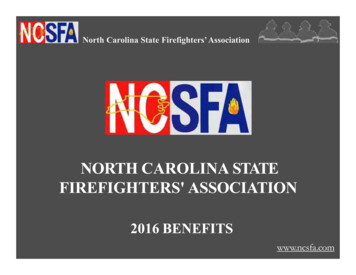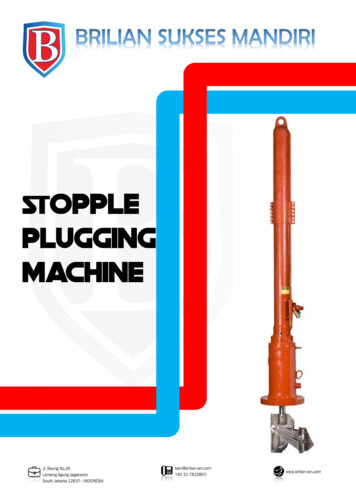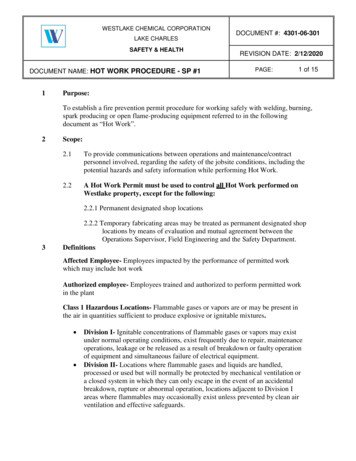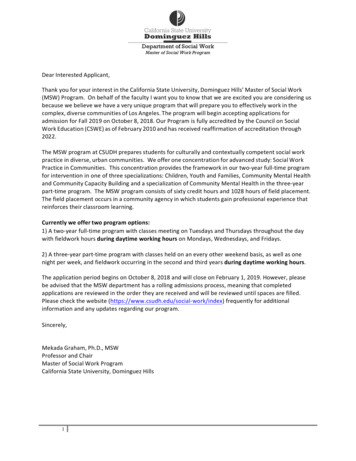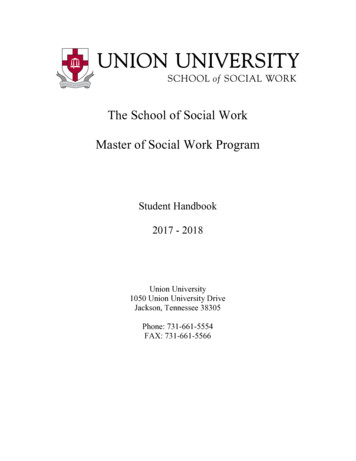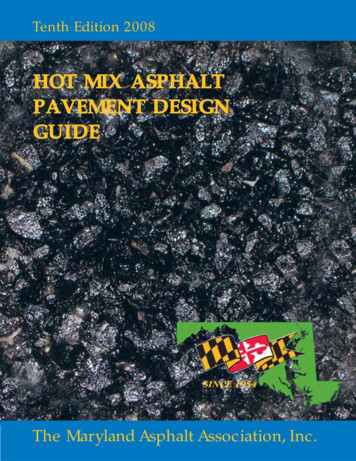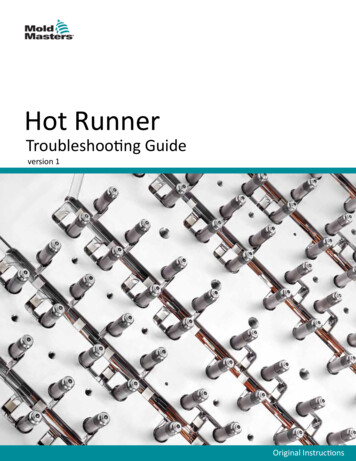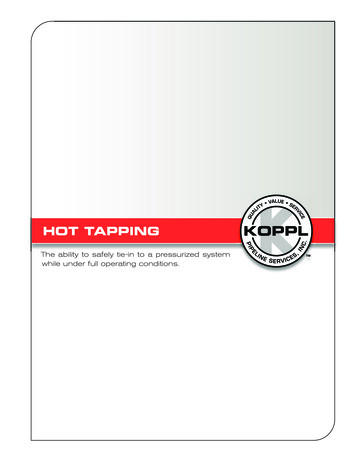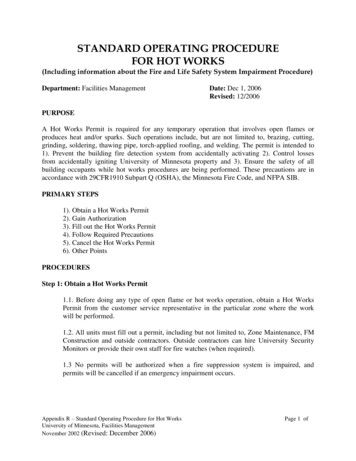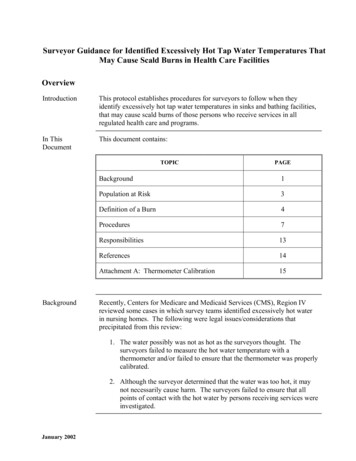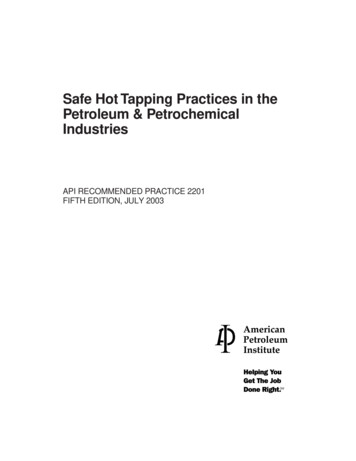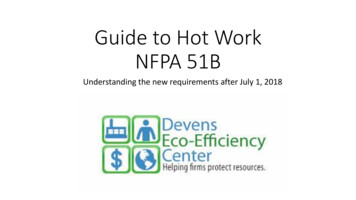
Transcription
Guide to Hot WorkNFPA 51BUnderstanding the new requirements after July 1, 2018
What is the issue that causedthe change? Unpermitted hot work was determined to bethe cause of a fire that killed twofirefighters, Boston Firefighter Michael R.Kennedy, and Lt. Edward J. Walsh on March26, 2014. After the Fire, Boston aggressively developeda regulation to prevent this from occurringagain. Boston passed these regulations first as ofJuly 1, 2018, Massachusetts adopted theseregulations. Many of those doing hot work may not beaware of the new regulations.
What changed? In summary Code requires a on site, posted permit for most hot work. Code requires that most of those doing Hot Work must take a trainingclass. Many fire departments will ask for proof of training for thoseapplying for a hot work permit. A Sphere of Safety – non combustible sphere of 35 feet around any hotwork is required. The building owner has to be aware and has some responsibility for hotwork in their building. Code now requires a Hot Work Safety Team made up of Person doing hot work (Hot Work Operator) Fire Watch Permit Authorizing Individual (PAI)
What is Hot Work Hot work is any activity or process that involves open flames or thatgenerates sparks or heat and includes: Welding and allied processes; heat treating; grinding; thawing pipes; powder-driven fasteners; hot riveting; torch-applied roofing; and any similar applications producing or using sparks, flame or heat.
Training Training is required and proof of training is a wallet card supplied by NFPA. 3 Ways are approved to get the training NFPA Hot Work Safety Certificate Classroom Training te-Classroom-TrainingP16766.aspx?icid A292 In person Class - 25 NFPA Hot Work Safety Certificate Online Training On-line Class - 45 te-Online-TrainingP18356.aspx?icid A292 The Gould Construction Institute https://www.gwgci.org/
Before Choosing Hot Work the Safety Team shouldevaluate Ways to Reduce or Eliminate Hot Work Hazards One process to reduce or eliminate hot work hazards is called“Recognize, Evaluate, and Control.” This process is covered in NFPA 51B and focuses on the following: Recognize – Determine if fire risks exist before hot work is started. Evaluate – Determine if hazards are present, especially hazards thatcould fuel a fire (flammable and combustible liquids or gases andsimple combustibles). Control – Take appropriate steps to eliminate or minimize thehazards.
Hot Work Safety Team –PAI – Permit Authorizing Individual In conjunction with management, the PAI shall be responsible for the safe operation of hotwork activities. 4.2.1 * The PAI shall consider the safety of the hot work operator and fire watch withrespect to personal protective equipment (PPE) for other special hazards beyond hot work.(See 5.1.) 4.2.2 The PAI shall determine site-specific flammable materials, hazardous processes, orother potential fire hazards that are present or likely to be present in the work location. 4.2.3 The PAI shall ensure the protection of combustibles from ignition by the followingmeans: (1)*Considering alternative methods to hot work (2)Moving the work to a location that is free from combustibles (3)If the work cannot be moved, moving the combustibles to a safe distance or having thecombustibles properly shielded against ignition (4)Scheduling hot work so that operations that could expose combustibles to ignition are notbegun during hot work operations 4.2.4 If the criteria of 4.2.3(2) through 4.2.3(4) cannot be met, hot work shall not be performed.
Hot Work Operator The hot work operator shall handle equipment safely and use it as followsso as not to endanger lives and property: (1) The operator shall have the PAI's approval before starting hot workoperations. (2) All equipment shall be examined to ensure it is in a safe operatingcondition; if found to be incapable of reliable safe operation, theequipment shall be repaired by qualified personnel prior to its next use orbe withdrawn from service. (3) The operator shall cease hot work operations if unsafe conditionsdevelop and shall notify management, the area supervisor, or the PAI forreassessment of the situation.
Fire Watch - Can be the PAI and in some cases, be PAI and Hot Work Operator. 4.4.1 * The fire watch shall be trained to understand the inherent hazards of the work site and ofthe hot work. 4.4.2 The fire watch shall ensure that safe conditions are maintained during hot work operations. 4.4.3 The fire watch shall have the authority to stop the hot work operations if unsafe conditionsdevelop. 4.4.4 * The fire watch shall have fire-extinguishing equipment readily available and shall be trainedin its use. 4.4.5 The fire watch shall be familiar with the facilities and procedures for sounding an alarm inthe event of a fire. 4.4.6 The fire watch shall watch for fires in all exposed areas and try to extinguish them only whenthe fires are obviously within the capacity of the equipment available. If the fire watch determinesthat the fire is not within the capacity of the equipment, the fire watch shall sound the alarmimmediately. 4.4.7 * The fire watch shall be permitted to perform additional tasks, but those tasks shall notdistract him or her from his or her fire watch responsibilities. No Where in the Code does it require that a Firefighter be the person providing the Fire Watch.The AHJ may determine in needs to be a firefighter based on the area and hazards.
When do Ineed aFireWatch
Where can Hot Work be done NFPA 51B Ch 3.3.3 Permissible Areas. 3.3.3.1 Designated Area. A specific location designed and approved for hot work operations that ismaintained fire-safe, such as a maintenance shop or a detached outside location,that is of noncombustible or fire-resistive construction, essentially free ofcombustible and flammable contents, and suitably segregated from adjacent areas.(This area is approved by the AHJ and Building Official during an annual inspection.The annual permit from AHJ is not needed for this area, No daily permit ) 3.3.3.2 Permit-Required Area. Any location other than a designated area that is approved for hot work and is madefire-safe by removing or protecting combustibles from ignition sources. This areawill require a permit from the Fire Department, and a posted daily Hot Work (inhouse) Permit issued by the PAI (Permit Authorizing Individual).
Permit Required Area12
Permit Required Area 35 Foot rule Fire Watch
Fire Department (AHJ) Permit A permit from the Head of the Fire department shallbe required to be issued by the AHJ additional to therequired Hot works permit as a preconditioning toperforming Hot Work. Always check with the AHJ Exemption: Designated areaspre-approved by the Buildingand Fire Officials.FP-006
Site Specific Hot WorkDo I need a permit? This decision treedetermines if aSite Specific HotWork Permit isrequired.
Hot Work Permit (On Site posted permit -24 hour limit) The hot work permit helps the permitauthorizing individual, hot workoperator, and fire watch recognizepotential hazards. Areas can be made safe with the useof welding pads, blankets, or curtains,clearing combustibles from a 35-footdiameter space around the hot work,or moving the hot work to an area freeof combustibles.
Hot Work35-FootRuleIllustrated
Non Permissible Areas: Hot work shall not be permitted in the following areas: (1)In areas not authorized by management (2)In sprinklered buildings where sprinklers are impaired, unless therequirements of NFPA 25, Standard for the Inspection, Testing, andMaintenance of Water-Based Fire Protection Systems, are met (3)In the presence of explosive atmospheres (i.e., where mixtures offlammable gases, vapors, liquids, or dusts with air exist) (4)In the presence of uncleaned or improperly prepared equipment,drums, tanks, or other containers that have previously contained materialsthat could develop explosive atmospheres (5)In areas with an accumulation of combustible dusts that could developexplosive atmospheres
Fire Department (AHJ)- permitExemptionExemption 1 – Those persons who hold a license from the Commonwealth who perform hot work as part of theirtrade and the hot work safety is part of their training. Must meet the 35’clearance rule. Examples:PlumbersElectricians A permit shall not be required from the fire department when theTin Knockers etc.hot work activity is performed by a person, or under the directsupervision of a person, licensed and permitted pursuant to aspecialized code as defined in M.G.L. c. 143, §96. However, such individuals must complete the training requirements. And comply with the rules prescribed for hot work Clear the area 35- foot rule Combustible walls/floors shall be kept wet, cover open cracks (within 35 ft.rule)protect walls, ceiling and floors with curtains, mats, blankets, etc. Education and permits governed by the licensing authority for that particular Board.21
Fire Department (AHJ)- permitExemptionExemption 2 – Home Owner or Hobbyist on their ownproperty. (Person welding scrap into sculpture on theirown property)Exception: Homeowners and Hobbyists No training requirements No permit requirements22
Fire Department (AHJ)- permitExemptionExemption 3 – Individuals who do hot work on their own equipment on theirown property .Ex. (Contractor who needs to weld a tooth back on hisback hoe on his own property) Individuals who conduct hot work operations on their premise orequipment shall be permitted to carry-out hot work, after consultationwith the AHJ before hot work operations can be conducted. Further,such person shall meet the training provisions, pursuant to 41.7 ofChapter 41. However, such individuals must complete the training requirements. And comply with the rules prescribed for hot work23
Questions
NFPA 51B Understanding the new requirements after July 1, 2018. What is the issue that caused the change? Unpermitted hot work was determined to be the cause of a fire that killed two firefighters, Boston Firefighter Michael R. Kennedy, and Lt. Edward J. Walsh on March 26, 2014. After the Fire, Boston aggressively developed a regulation to prevent this from occurring again. Boston .
